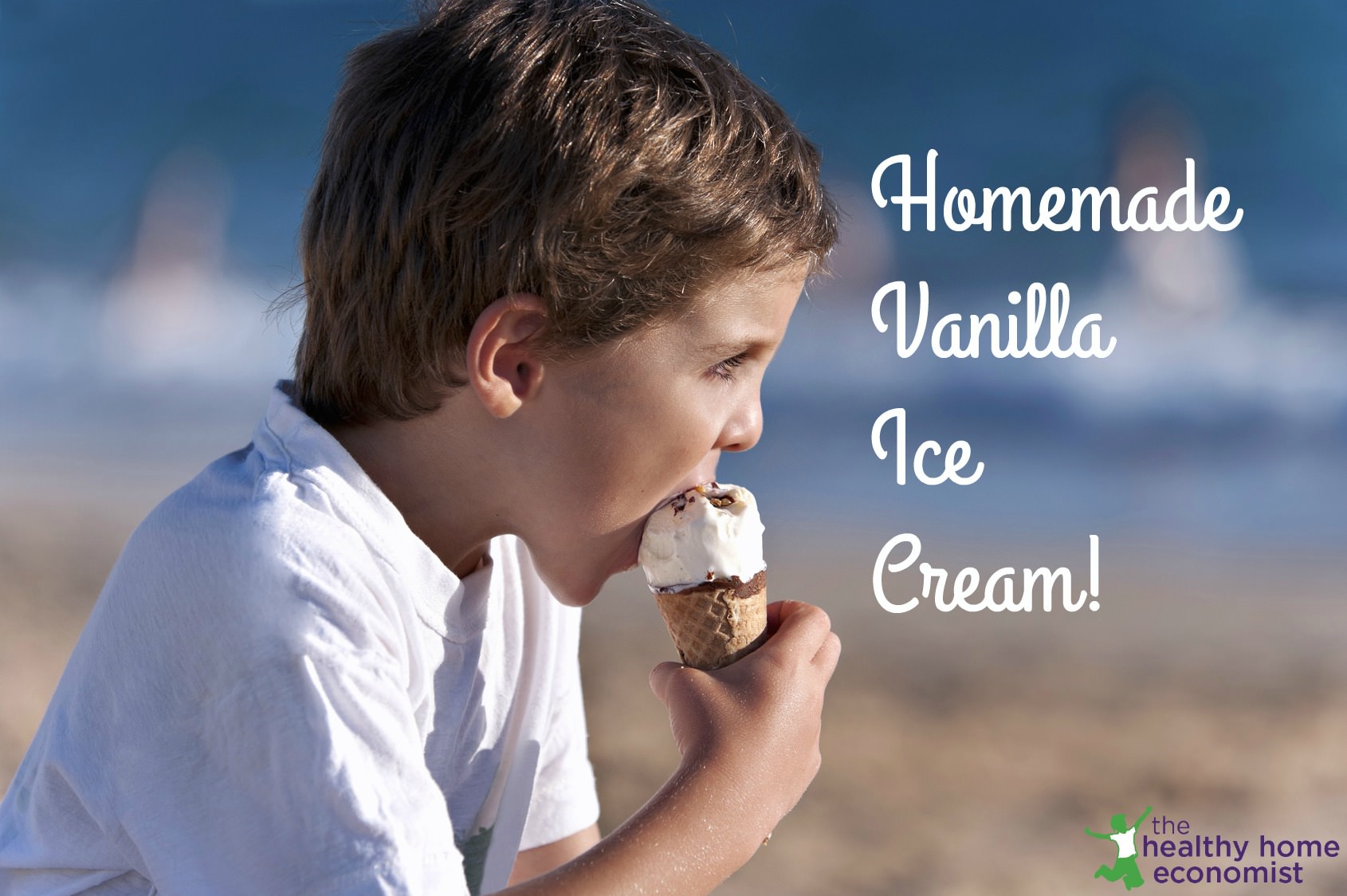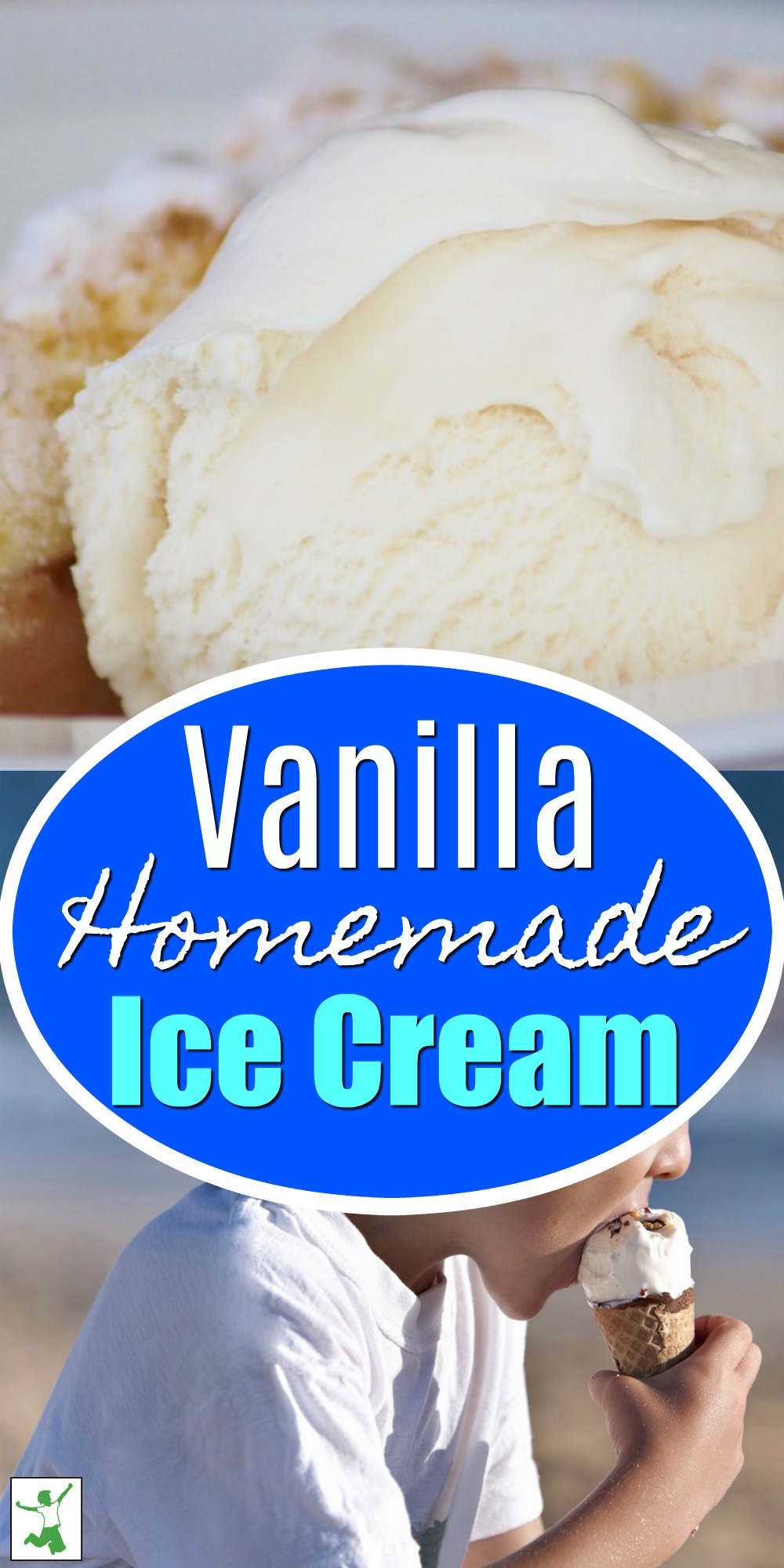
As a follow-up to a blog from earlier this week regarding toxic chemicals like propylene glycol, aka antifreeze in commercial ice cream, this recipe plus video shows you how to make homemade vanilla ice cream with wholesome, nutrient-dense ingredients.
There is simply no substitute for making ice cream yourself. I’ve often advised people over the years that the best use of your time in the kitchen is making things you can’t easily buy. Wholesome, healthy ice cream is one of these “things”. Bone broth is another important one, by the way, on the savory side of the spectrum!
Even organic ice cream is loaded with refined “organic” sugar. The homemade version contains Grade B maple syrup, a much healthier and more mineral-rich choice.
Not only is the sugar non-refined in homemade ice cream if you use Grade B maple syrup, but much less sweetener is used as well. For example, in the recipe below, 1/2 cup of homemade vanilla ice cream contains approximately 12g of sugar (in the form of maple syrup). The same amount of Julie’s Organic Ice cream (vanilla) contains 18g of sugar and Haagen Daaz plain vanilla contains 21g of sugar!
That is a lot less sugar in the homemade vanilla ice cream!
Of course, the cream you would source for homemade ice cream is higher quality too. Low temp pasteurized or (preferably) fresh cream from a grass-based dairy farm would contain far more nutrition than the cream from even organic cows, which are frequently still confined eating highly unnatural “organic” feed.
You will immediately notice that when you make your own ice cream, it is much more satisfying and you won’t eat nearly as much as supermarket ice cream. The lower butterfat content in supermarket and even organic ice cream results in eating more – much, much more. Believe me, ice cream manufacturers know this fact very well!
You eat more, they SELL more! Cha-ching!
Julie’s Organic Ice Cream, for example, contains cream and the second ingredient is skim milk. Remember – pig farmers feed their pigs skim milk to make them very, very fat). A lower butterfat content in your ice cream will cause you to eat more, a LOT more, which is why homemade ice cream with high butterfat will satisfy you quicker and you will eat far less.
If vanilla ice cream is not your thing, check out this recipe for dairy-free peanut butter ice cream.
How to Make Vanilla Ice Cream (+ Video Tutorial)
The video in the recipe below shows you how easy it is to make vanilla ice cream yourself.
Try drizzling this no-cook homemade chocolate syrup on top for a healthy treat with no compromises!
What a huge difference from commercial brands Twistee Treat or Jack Nicklaus Ice Cream, which is artificial almost everything! Even organic brands contain nearly double the sugar and are low butterfat to encourage overeating and check the politically correct nutrition box.


Homemade Vanilla Ice Cream Recipe
How to make homemade vanilla ice cream using only wholesome ingredients that contains about half the sugar of even organic or premium brands at the store.
Ingredients
- 3 egg yolks preferably pastured
- 3 cups heavy cream preferably raw and grassfed
- 1/2 cup maple syrup dark
- 1 Tbl vanilla extract
- 1 Tbl arrowroot powder
- 2 Tbl vodka optional (to soften and improve scoopability)
Instructions
-
Beat egg yolks briefly in a large, glass bowl. Do not use regular store eggs. Preferably use local, free range or pastured eggs washed in warm, soapy water before cracking. Organic store eggs are ok in a pinch.
-
Beat in remaining ingredients and pour into your ice cream maker. Follow your ice cream machine directions for how long the ice cream is churned.
-
When the ice cream is frozen and ready (about 15-20 minutes for my machine), pour into a shallow, glass baking dish. Cover with a lid and keep in the freezer.
Recipe Video
Recipe Notes
Do not use ultrapasteurized cream as it is highly allergenic and basically undigestible.








Holly, after I read the article and commented, I watched the video and I believe Sarah does mention that it’s “okay” yet not ideal, to use organic pasteurized cream is raw is not available. My challenge is I’m even having issues finding any organic cream where I live that is not ultra-pasteurized. Ugh. The search continues…
What if I can’t get fresh, raw cream? Raw dairy is illegal where I live 🙁 and it’s hard enough just to get raw milk! I know I could skim it off the top but that would take a LOT of milk! Is it okay to substitute organic cream as long as it’s not the ultra-pasteurized?
I am wondering the same thing.
This was soo amazing! It knocked out my pregnant-woman ice cream cravings! Thanks for the recipe!
I am in the market for an ice cream maker and am wondering what you recommend in terms of what the freezing container is made of (where the ice cream comes into contact with the walls of the vessel.) It is very difficult to tell on the websites I have looked at and I am wondering if it makes any difference since we are freezing and not cooking?
P.S. I am new to WAPF. Thank you ten fold for your blog and all your videos. From someone who is starting from scratch, THANK YOU!
Hi,
My raw cream is not pourable. It is quite thick. Should I add some milk to it so it is pourable like yours? This recipe looks great. Thank you, Sue
Hi Sarah
Glad I found your blog via Radiant Life and Weston Price. Just a question about the name of the brand of sourdough presliced bread you buy.
Thanks a bunch, Renee
Hi Sarah,
I’ve been making ice cream for years following my grandmother’s recipe. Unfortunately it called for sweetened condensed milk and evaporated milk so I’ve been searching for a better recipe. I have found a few (you’re is churning on my counter as I type) but all call for only egg yolks. My grandmother’s recipe used whole eggs and even when I scaled it down to fill my Cuisinart Ice Cream Maker I always used whole eggs. What is the objection/reason for recipes these days to use only the yolk?
thanks!
blessings!
Hi Danielle,
Egg yolks are richer and have a smoother texture than egg whites, hence the reason why custard and ice cream recipes prefer the former over the latter. The egg yolk also contains almost all of the nutrients in the egg, and 40% of the protein. Cooking the egg yolk causes it to loose some of its nutritional quality. The white, however, contains enzyme and B-vitamin inhibitors, and therefore should be cooked for the best nutrient absorbtion. That’s why the best way to cook eggs is to soft boil them, or fry them over easy or sunny-side up!
Hope this helps!
Ariel
I forgot to mention that heat destroys the inhibitors found in the egg whites, and that’s why they should be cooked.
Hello,
Must the eggs go into the ice cream maker RAW? Most other recipes call for heating the milk/cream to steaming, then tempering it into the whisked eggs….then all goes back into pot until about 170 degrees. Mix is then cooled overnight and then goes into the maker. Point being…is there a way to cook the egg yolks for safety sake…then into ice cream maker? Thanks in advance.
The point of this ice cream recipe is that it is raw; we are preserving enzymes and nutrients. And if you are sourcing fresh, local eggs from healthy hens, and the eggs are washed just prior to use, there is almost NO risk of salmonella poisoning, and even if some salmonella did get in your ice cream, freezing it would kill it off! Trust me, I know from experience. I have been adding lots of raw, local egg yolks to my smoothies many a morning for several years now, and have never once gotten sick. Neither has the rest of my family, and we are always eating raw egg yolks.
I made this today in a borrowed Cuisinart ice cream maker and it is DELISH! Out of the freezer it melts very quickly so we had to eat fast! There is no chemical aftertaste as with store-bought boxed ice cream (even the natural ones!) I could kinda taste the egg yolk a little though – my imagination? It wasn’t a bad taste or anything. I did forget to wash the local free-range eggs in warm soapy water. (I just washed in water). Hope I don’t get a tummy ache! Thanks for posting this!
p.s. How do I make it with rapadura/sucanat instead of maple syrup? Hubby has very sensitive taste buds and isn’t used to maple ice cream. 🙂
Wow, he can taste the maple syrup flavor? I’m kind of impressed; I sure couldn’t!
I disolve the required ammount of sucanat in about 2/3 of said ammount in water (the exact ammounts depend on how much I’m making). I will usually heat the water until it feels very hot, but not burning, to the touch. This helps to speed up the disolving process. Mind you, though, it can still take a bit to be completely disolved.